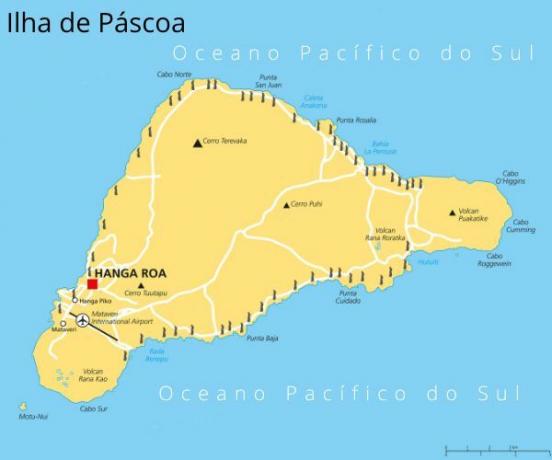Easter Island (Rapa Nui) is a territory located in the oceanic region of Polynesia, in the South Pacific. It is a territory belonging to the Chile incorporated by the South American country in 1888, and remains so until the present. Due to its relative isolation, many mysteries surround Easter Island, such as the construction and installation of the moais, giant statues with human features found in different areas of the island. Today, 7750 people live on Easter Island, who develop an economy based on tourism, agriculture and fishing.
Read too:Tonga — an archipelago country located in the Polynesian region
Easter Island summary
Easter Island (Rapa Nui) is located in the Polynesian region of the South Pacific.
It is a Chilean territory of 163 km² in area, with capital in Hanga Roa.
The island is formed by volcanic rock and extinct volcanoes, with relief characterized by the presence of hills and craters. Altitudes are around 500 meters.
Easter Island's climate is marked by mild, dry summers and cool, rainy winters, with temperatures ranging between 18 and 23 °C.
The native vegetation of Easter Island is sparse. There is mainly undergrowth and low growth vegetation, such as shrubs. In some areas there is a concentration of trees, many of which are the result of reforestation actions.
The population of Easter Island is estimated to be 7750 people. The native population (rapanui) represents half of the inhabitants of the island.
The construction and displacement of the large statues characteristic of Rapa Nui are some of the mysteries associated with the island.
Agriculture, fishing and tourism are the main economic activities developed on Easter Island. The Rapa Nui National Park is one of the most popular tourist destinations for the 100,000 visitors who arrive on the island every year.
The island was occupied from the 8th century by other Polynesian peoples.
Europeans arrived in the 18th century, when the island was named Easter Island by the Dutch navigator Jacob Roggeveen, who arrived there in 1722.
It became part of the Chilean territory in 1988 and remains so until the present.
Location of Easter Island
Easter Island, also called Rapa Nui in the local language, is a territory located in the Polynesian region, in the southwest portion of Pacific Ocean. It is a dependency of Chile located southeast of French Polynesia and close to the Pitcairn Islands, belonging to the UK. The approximate distance between Easter Island and Chile is 3540 km.

Easter Island Geography
Easter Island is a Chilean territory with an area of approximately 163 km³ and coast bathedO across the south pacific. The capital of Easter Island is the city of Hanga Roa, located in the southwest of the island and where most of its population lives.
It is a Chilean province relatively isolated from the other Polynesian dependencies. The nearest territory to her is about 2 thousand km away. Easter Island is in the GMT -5 time zone.
→ Relief of Easter Island
The characteristic triangular shape of Easter Island is the result of the presence of three volcanoes that are now extinct and predominantly composed of a porous rock called tuff. All the relief insular is carved on volcanic rocks and characterized by the presence of hills and craters. The average altitude of Easter Island is 507 meters above sea level. Its highest point is Mount Terevaka, which is 603 meters high.

→ Easter Island weather
O climate that takes place on Easter Island is the climate subtropical, characterized by summers dry ranging from mild to hot and winters rainy and cool. Temperature averages range from 23 °C in the corresponding summer months to 18 °C in the coldest winter months, generally between June and August. Annually, a volume of rains of 1250 mm, which are concentrated in the first months of winter, while in spring rainfall rates are the lowest of the year.
→ Easter Island vegetation
The native vegetation of Easter Island is sparse, and a portion of the trees, wildflowers, shrubby plants and mosses found in the outbuilding are of European origin. The intensification of land use for the development of agricultural crops and possible animal pests (such as rats, which happened right at the beginning of the occupation by the Polynesians) are some of the explanations for the low floristic density of the Island of Easter.
The way in which the porous rocks of the substrate quickly absorb rainwater also helps us to understand the absence of large vegetation and preponderance of low-lying species, which constitute landscapes similar to the steppes.
There are some reforestation actions on Easter Island that aim to restore part of the island's vegetation cover, one of them developed by the National Forestry Corporation (Conaf), a Chilean authority that has taken Polynesian native species to island.
See too: Marshall Islands — a country in Oceania made up of more than a thousand islands
Easter Island Demographics
Easter Island is inhabited by 7750 people, according to the most recent estimates by Chile's National Institute of Statistics (INE). The last demographic census was carried out on the island more than a decade ago, in 2012, when the mapped population was then 5761 people. O population growth on Easter Island is a tendency that appears in previous surveys, since in 2002 there were 3791 people living in the territory.
Both Chileans and the native population live on Easter Island from the island, who are the Rapanui peoples, originally from Polynesia. At the end of the 20th century, there were estimates that the natives represented more than 70% of the total population of the island, currently corresponding to approximately half of its inhabitants. Today there is a movement of the Rapanui population towards Chile, mainly university students who move temporarily to later return to their homeland.
The capital of Rapa Nui, the city of Hanga Roa, has more than 3,000 inhabitants. Some of the main economic activities developed in the city and on the island are agriculture and fishing. There is, in addition, a portion of the population that travels to work in Chile with certain periodicity, making the round trip once or twice a week.
Easter Island Culture
Due to its isolation, Easter Island has a very rich and unique culture. Two languages are spoken in the territory: Spanish and Rapanui (or Vananga Rapanui), a language of Polynesian origin and spoken in everyday life, especially among family members.
The main religion is the native religion of the Rapanui, whose principle is the worship of ancestors and elements of nature, such as birds. The maximum deity of the Rapanui belief is named Make-Make, associated with fertility.
![Dance presentation with typical clothes of the Rapanui culture. [1]](/f/0db89f1f9148773e8927b5cc15019203.jpg)
Annually, in the month of February, the Tapati Rapa Nui (Semana Rapa Nui, in the local language), Easter Island's main cultural festival. During the festivities, typical dances are performed in the form of competitions, in which participants wear traditional clothes in honor of their ancestors. Among these typical clothes is the hami (or maro), made with dry grass. Vegetable fiber hats, headdresses and feather ornaments are also widely used.
To the tattoos and body paints are important elements of Rapanui culture and other Polynesian traditions. They are related both to religious and spiritual beliefs and to life in society.
Mysteries of Easter Island
Easter Island is famous for the mysteries that surround it. This happens due to its relative isolation from other territories and people's lack of knowledge about the cultural traditions of the native Rapa Nui population.
Among the most celebrated mysteries on Easter Island are mystery about the giant statues carved with human faces which are distributed across the island, from about 4 to 10 meters high and weighing 14 tons. Some heavier ones can reach a weight six times greater than that. These statues are called moai and there are around 600 of them across Easter Island.

The construction of the moai is closely linked to the spiritual beliefs of the Rapanui. The moais were initially carved in basaltic rocks, later moving to the volcanic rocks of the crater of Rano Raraku, formed from ash and other debris originating from volcanic activity (tuft). It is believed that moai were built after the death of an ancestor or ruler, and these structures had the spiritual power to protect the people who built them.
The moais were built in the interior of the island and then transported to the ahu (altars) on the coast. The way in which this displacement took place is still a mystery, which has some possible explanations, the most accepted being that of that logs were used positioned in such a way as to form a kind of conveyor belt, wooden sleds and ropes for their installation. Part of the moai is buried in the ground. Most of them have male features, but there are at least 12 moai with female features and anatomy.
Easter Island Tourism
tourism is the Easter Island's main economic activity, which receives around 100,000 visitors annually. The mysteries that surround Rapa Nui, the cultural richness of its population and the natural beauties are its main tourist attractions.
Most tourists go to Rapa Nui National Park, created in 1935 and listed as a world heritage site by the Unesco in the year 1995. In the area corresponding to the park, it is possible to see some of the characteristic moai of Easter Island, among which 15 moais stand out. restored and installed in the Ahu Tongariki, the largest on the island, which are lined up next to each other, and the crater of the ancient Rano volcano Raraku.
Beaches like Anakena, made up of white sand and coral reefs, the various caves and petroglyphs that can to be found there, as well as the local restaurants, are other tours that are very popular with visitors to the Island of Easter.
History of Easter Island
Archaeological records indicate that the settlement of the island of Rapa Nui began around the 8th century CE, when inhabitants from other territories of Polynesia arrived and created their first settlements there.
Some of the first statues, the moais, were built between the centuriess X and XI, as well as the altars where they were installed. It is further believed that two of the groups that lived on the island came into conflict around the 17th century, causing a civil war that was devastating for the Rapa Nui population.
In the 18th century, the first foreign visitors landed on the island., coming directly from Europe. Dutch explorer Jacob Roggeveen was a pioneer among Europeans, arriving on the island around Easter in 1722.
For this reason, that territory was named Easter Island or Paaseiland in Dutch. British and French explorers, at the behest of the Spanish Viceroy of Peru, also passed through the island from the second half of the 18th century onwards.
During the 19th century, the enslavement of part of the population, taken by force to the Peru, and diseases that were introduced by foreigners caused many casualties in the population of Easter Island.
On September 9, 1888, Chile incorporated Easter Island into its territory. through the signing of the Treaty of Annexation of the Island with the Rapanui, who later also became Chilean citizens.
image credit
[1] Christian Wilkinson / Shutterstock
By Paloma Guitarrara
Geography Teacher
Source: Brazil School - https://brasilescola.uol.com.br/geografia/ilha-de-pascoa.htm

